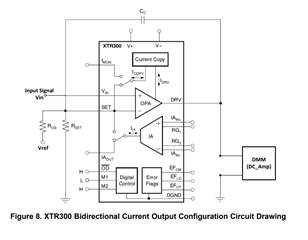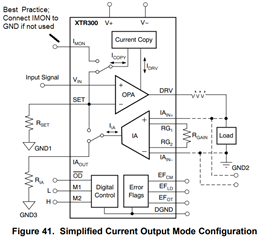
As shown in the picture above, I_MON , IA_OUT , IA_IN+ , RG1 , RG2 , IA_IN- are unused. Should I leave them electrically unconnected? If it is not correct, what should I do with these unused pins?
This thread has been locked.
If you have a related question, please click the "Ask a related question" button in the top right corner. The newly created question will be automatically linked to this question.

As shown in the picture above, I_MON , IA_OUT , IA_IN+ , RG1 , RG2 , IA_IN- are unused. Should I leave them electrically unconnected? If it is not correct, what should I do with these unused pins?
As shown on page 17 of the datasheet, IMON and IAOUT must not be left open. They can be shorted to ground.
RG1,2 can be left open (RGAIN = ∞) to minimize the gain of the IA. IAIN+,− can be configured as if for a load with zero current, i.e., short them together, and to GND.
HI Tan,
In voltage mode, IMON produces a current that is 1/10th of IDRV and if left floating, it will saturate the current mirror.
When in current mode, best practice is to connect IMON to GND with a ~kiloOhm RIMON resistor to GND; or alternatively short directly to GND. Do not leave the IMON pin floating.
The instrumentation amplifier, (IA) while in current output mode, produces an output current (IIA) proportional to the voltage at the IA input voltage and is used to monitor the load voltage. The external resistor RIA converts this current output into voltage. If you do not wish to use the instrumentation amplifier, the IAOUT pin must be shorted to GND, and this pin should not be left disconnected; the IA+ and IA- inputs must be also shorted to GND. You could connect the RG1 and RG2 pins together with a >~10kOhm or larger resistance. When the IA+ and IA- inputs are grounded, the VIN voltage at the instrumentation amplifier is zero, the IAOUT pin current output will be close to zero per the below equation (5) of page 22. Page 17 has some information/recommendations about these pins.

Thank you and Regards,
Luis

